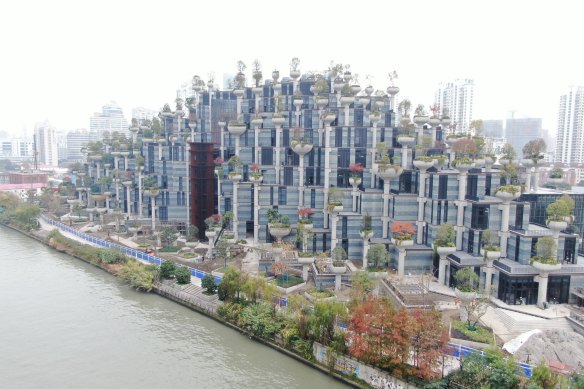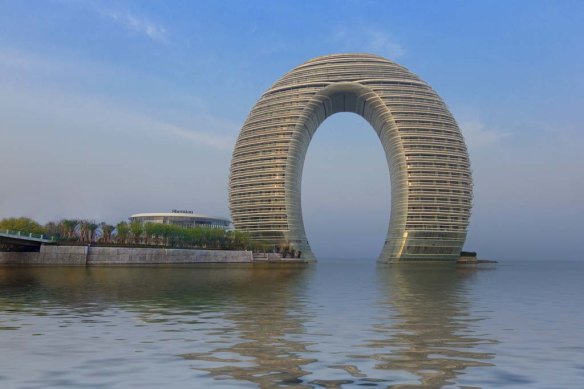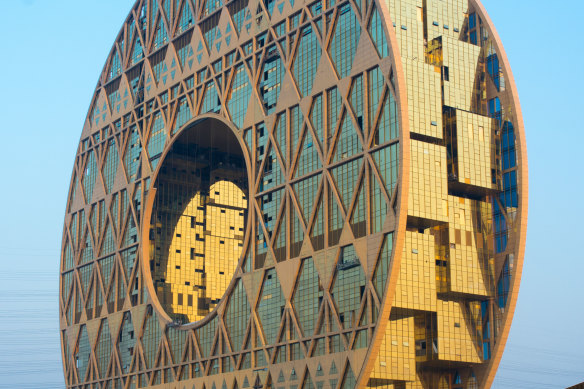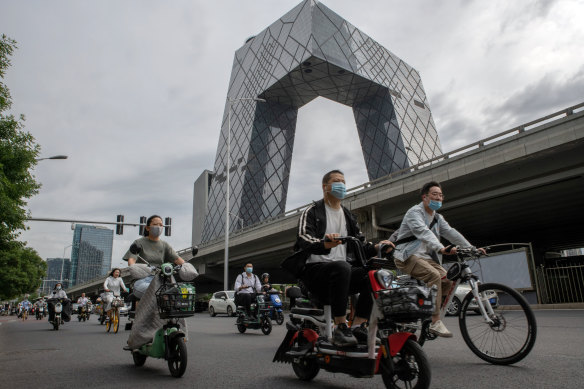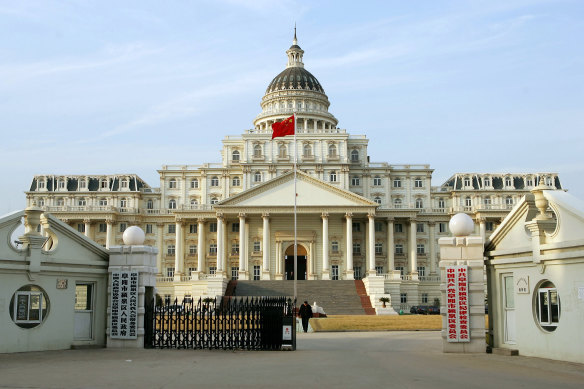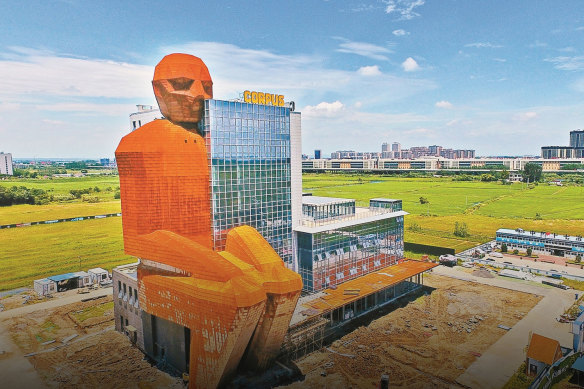Save articles for later
Add articles to your saved list and come back to them any time.
A Shanghai shopping centre that mimics the Hanging Gardens of Babylon. A museum in Maanshan, Anhui province, with a giant seated figure resembling a toilet built into its side. An opera house in Guangxi shaped like a metallic osmanthus, a flower.
These are some of the most extravagant – and visible – symbols of China’s meteoric economic rise in the last few decades. But they are also among the latest winners of the annual Ugliest Buildings Survey, released in January. The online poll started by Beijing-based architecture website Archcy.com is now in its 13th year.
An aerial view of 1000 Trees, a series of high-rise buildings and shopping centre designed by British architect Thomas Heatherwick, dubbed as the Hanging Gardens of Babylon in Shanghai.Credit: Alamy
“The hyper-speed urbanisation of the past two decades has led to an explosive overbuilding everywhere in the nation,” wrote Zhou Rong, one of the survey’s founding judges and an associate professor of architecture at Tsinghua University, in an essay in 2020.
“Lacking regulation, the construction spurt has been like sprinting blindfolded, outstripping public consensus and leading to a breakdown in cultural thought and design.”
As a result, buildings that imitated or idolised foreign cultures began to proliferate. They prioritised magnitude, flaunted wealth, pursued oddity for the sake of novelty, or were of shoddy quality, according to Zhou. For some, they are architectural and engineering marvels.
The Ugliest Buildings Survey was created against this backdrop, surfacing as a critique of this era as well as an emotional outlet for the Chinese public to vent, he wrote.
The public backlash against such buildings has been so severe that even the government has stepped in, likely at the behest of President Xi Jinping, who has personally called for an end to “weird buildings”.
The Sheraton Huzhou Hot Spring Resort on China’s Lake Taihu has features including a “wedding island”. The architects may not appreciate the description, but the 321-room hotel looks a bit like a squished donut.
Last year, China’s top economic planner released an ambitious urbanisation plan designed to “optimise” city life “with Chinese characteristics”, in adherence to “Xi Jinping thought”. It reiterated a ban on “oversized, xenocentric, odd” buildings and an earlier restriction on the construction of skyscrapers over 500 metres.
But the trend showed no signs of stopping.
“We thought the contest would run out of material in a year or two, but even now ugly buildings are still mushrooming,” said Zhou at a public lecture in 2022. “The only thing that’s changed is their form of ugliness.”
To sift through the poll’s winners over the years is to trace the evolution of aesthetics in modern Chinese architecture. Many of the earlier finalists were representative of the shanzhai culture in the 2000s, a term which connotes creative counterfeiting.
The Guangzhou Circle in Guangzhou, China. Credit: Shutterstock
These could include buildings such as replicas of the US Capitol building or Tiananmen Square, which popped up around the country. The Anhui museum, due to open this year, is a branch of the Corpus Museum in the Netherlands.
But before that was Shanghai’s infrastructure splurge, where China’s first mega-projects of spectacle of the post-reform era can be found.
In the 1980s, Pudong, the eastern part of the city, was all farmhouses and shipyards. Political leaders saw an opportunity to build a global financial hub on par with London and New York.
The plan included the development of three skyscrapers in a tight cluster that would become a visual shorthand of Shanghai’s future. The first was the 468-metre-high Oriental Pearl TV Tower, completed in 1994 – then the highest tower in Asia. The last of these to be built, the 632-metre Shanghai Tower, was completed in 2015 and is still the world’s third-tallest building.
Other Chinese cities began emulating Shanghai’s model.
“When you have local government officials keen on developing areas of cities that are meant either for tourist purposes or for attracting businesses, they do want signature buildings,” said Wu Weiping, an urban planning professor at Columbia University.
It was the 2008 Beijing Olympics, however, which firmly swung the pendulum towards bombastic buildings as a way to showcase China’s progress to the world. These include the CCTV “Big Pants” headquarters designed by Dutch architect Rem Koolhaas, the egg-shaped National Grand Theatre, and sports venues like the latticed Bird’s Nest stadium and Water Cube aquatics centre. Xi even targeted the CCTV building in his 2014 speech lambasting “weird buildings”.
Motorists travel past the China Central Television (CCTV) Tower in Beijing, China. It’s been dubbed the “Big Pants”.Credit: Bloomberg
But the experimental building boom continued, as economic growth soared and designers saw China as a loosely regulated tabula rasa to test the most outlandish ideas. The Italian-designed Circle Building in Guangzhou, which was completed in 2014 and resembles a golden doughnut, and the coin-shaped Fang Yuan building in Shenyang are past Ugliest Buildings winners.
Other over-the-top showpieces that populated the ranks of the poll are buildings resembling a liquor bottle, folk deity statues, a babushka doll, a gold ingot, a violin and even a crab. The list goes on.
More recently, criticism of the prize has centred on issues of cultural sensitivity as more international designers have taken the title.
Tian An 1000 Trees, the shopping centre in downtown Shanghai designed by British architect Thomas Heatherwick – it won in 2022 – was lambasted for its resemblance to a traditional Chinese tomb. It features tree-adorned columns sloping down a stepped terrace, reminiscent of a cemetery – a particular point of controversy during China’s wave of COVID deaths last year.
A public building in Fuyang, China, whose design is meant to be a cross between the White House and US Capitol.Credit: Getty Images
The 2019 winner was the Moshe Safdie-designed Raffles City Chongqing, which judges said “brutally trampled on Chongqing’s heritage”. The eight towers erected over the city’s waterfront was also criticised for being too similar to Singapore’s Marina Bay Sands resort, another Safdie design.
To Chongqing native Alice Gao, the Raffles City is “tu”, a Chinese word for earth or soil which colloquially means unrefined or crude.
“Chongqing is a mountainous city, but this landmark doesn’t meld with the surrounding landscape, the towers jut out like nails,” said the 42-year-old marketing professional. “I reject it in my heart. A building stays for a long time – when it’s ugly, that impacts an entire local generation and our memory of the city.”
Under construction but already awarded: The CORPUS Museum branch in Maanshan, Anhui province, China.
Three years of pandemic may at last usher in a new chapter for China’s ugly buildings. After decades of infrastructure binge, debt-laden local governments are now moving more cautiously.
Housing regulators last year issued new rules on building low-carbon cities, towns and villages, where at least 70 per cent of the housing must be six stories or fewer. High-rises and massive signature buildings will also be de-emphasised in favour of amenities that may not earn immediate revenues.
But as the country seeks to bolster its post-COVID economy, it may be tempted to once again build itself out of a slump, as land sales remain one of the most important sources of local government income. Top leaders have vowed to maintain a “necessary” magnitude of public spending in 2023, and construction activity has roared back.
Even then, reverting to the old playbook of vanity buildings no longer makes much sense. Beijing’s “common prosperity” campaign discourages ostentatious displays of wealth and excess.
A more patriotic China is also warier of catering to foreign tastes and enlisting international architects, with officials and competitors for commissions increasingly embracing conservatism.
“As our civilisation figures out its cultural identity through public architecture, trial and error is part of the process,” said Zhou, the competition judge. “What’s important is to have a mechanism for self-correction. That’s the Ugliest Buildings Survey — it’s the sword of Damocles hanging overhead.”
Bloomberg
Most Viewed in World
From our partners
Source: Read Full Article

